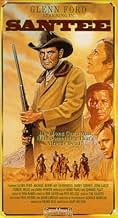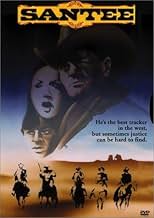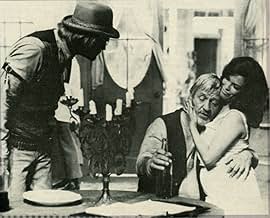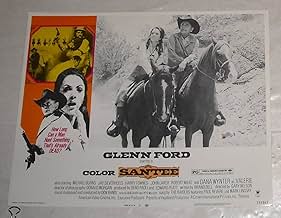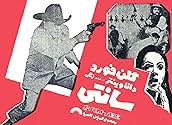Ajouter une intrigue dans votre langueA bounty hunter takes in the son of a man he killed.A bounty hunter takes in the son of a man he killed.A bounty hunter takes in the son of a man he killed.
- Réalisation
- Scénario
- Casting principal
Robert J. Wilke
- Deaks
- (as Robert Wilke)
Avis à la une
Glenn Ford who was associated with some of the best westerns ever made has his last starring role in the genre in Santee. Although he would do more westerns up to almost the end of his career, he would no longer be the leading man/action hero in any of them.
Ford was 57 when he made Santee and even in this one he's transitioning to be a father figure, much the same way John Wayne was in films like Big Jake, Rio Lobo, and The Cowboys.
Unfortunately Santee takes it's plot from a combination of Henry Fonda's The Tin Star and Robert Mitchum's Young Billy Young. Ford is a former lawman, turned bounty hunter who decides that marshaling doesn't give him quite the latitude he needs to deal with bad guys. It also doesn't pay as well. But having his son shot down by John Larch and his gang was enough to turn him bitter.
He's also forced to kill Robert J. Wilkie another outlaw who has a son in Michael Burns. But he takes Burns into his home. Truth be told there wasn't much attachment there anyway, Burns hardly knew him.
Jay Silverheels has the best part in the film as Ford's loquacious ranch foreman. I do believe he had more dialog here than in over 200 episodes of The Lone Ranger. Dana Wynter has a few scenes as Ford's wife and makes them count.
But Santee is just a tired rehash of a pair of better films. Glenn Ford fans will like it though.
Ford was 57 when he made Santee and even in this one he's transitioning to be a father figure, much the same way John Wayne was in films like Big Jake, Rio Lobo, and The Cowboys.
Unfortunately Santee takes it's plot from a combination of Henry Fonda's The Tin Star and Robert Mitchum's Young Billy Young. Ford is a former lawman, turned bounty hunter who decides that marshaling doesn't give him quite the latitude he needs to deal with bad guys. It also doesn't pay as well. But having his son shot down by John Larch and his gang was enough to turn him bitter.
He's also forced to kill Robert J. Wilkie another outlaw who has a son in Michael Burns. But he takes Burns into his home. Truth be told there wasn't much attachment there anyway, Burns hardly knew him.
Jay Silverheels has the best part in the film as Ford's loquacious ranch foreman. I do believe he had more dialog here than in over 200 episodes of The Lone Ranger. Dana Wynter has a few scenes as Ford's wife and makes them count.
But Santee is just a tired rehash of a pair of better films. Glenn Ford fans will like it though.
Another movie from the Mill Creek 200 cult cinema box set.
Pretty good western about a bounty hunter who takes in the boy of the man he killed. Teaches him the ropes and becomes like a father to him.
I liked this, not to big on westerns but very well done. Glen Ford is great as Santee. All around good movie.
Pretty good western about a bounty hunter who takes in the boy of the man he killed. Teaches him the ropes and becomes like a father to him.
I liked this, not to big on westerns but very well done. Glen Ford is great as Santee. All around good movie.
I spoke to Ed Platt in early 1974, not long before his death. If he was troubled by the financial failure of "Santee," he didn't show it; he was warm and unpretentious. We had a common interest in video production, which probably helped him open up. In any event, I didn't see "Santee" for more than 35 years; I must say, Ed's innovative use of video to film hurt the movie; and, as a relatively novice producer, Ed should have played it safe and stayed with film. The interior shots appear horribly lit, and the initial scenes are cluttered and almost tedious. However, after Glenn Ford shows up, the movie loosens up, and we get a pretty well written, expertly acted movie. The casting, particularly of Ford, Michael Burns, Harry Townes and Jay Silverheels is especially inspired. Dana Wynter seems an odd choice, especially since the reddish lighting makes her look Native American, and she can't completely disguise her British accent. However, Wynter's chemistry with Ford and Burns is downright terrific, and she dominates every scene.
"Santee" needs more fleshing out, and the money spent on the flashback could have been been spent building Ford's relationship with Burns. The ending comes too soon and too abruptly. Nonetheless, "Santee" is one of Ford's better westerns, certainly better than "A Time for Killing," "Day of the Evil Gun" and "The Last Challenge." As Ford's last starring western it is a flawed, if fitting tribute to one of the great cowboy actors.
I give "Santee" a "6".
"Santee" needs more fleshing out, and the money spent on the flashback could have been been spent building Ford's relationship with Burns. The ending comes too soon and too abruptly. Nonetheless, "Santee" is one of Ford's better westerns, certainly better than "A Time for Killing," "Day of the Evil Gun" and "The Last Challenge." As Ford's last starring western it is a flawed, if fitting tribute to one of the great cowboy actors.
I give "Santee" a "6".
Santee is directed by Gary Nelson and written by Brand Bell. It stars Glenn Ford, Michael Burns, Dana Wynter and Jay Silverheels. Music is scored by Don Rand and photography is by Donald Morgan. Plot finds Ford as seasoned bounty hunter Santee, who after killing the outlaw father of young Jody Deaks (Burns), takes him under his wing at his Three Arrows Ranch. With both of them nursing loses in their lives, they both come to be great for each other, but just as harmony is abundant at the ranch, news comes that the outlaw gang responsible for Santee's pain is back in town.
No country for empty pockets and a flat stomach.
Primarily shot on location in Santa Fe, New Mexico, Santee is notable for a couple of things. Firstly it was the last time that Western legend Ford would play a lead role in the genre, secondly is that it was filmed on video tape. Some debate exists as to if it was the first film to be shot that way, but certainly the research suggests it was definitely the first Western. Santee is a strange film in many ways, for sure as a film it's not a great lead role send off for Ford, but he is actually very good in it. The story is a good one from Bell, full of emotional worth and maintaining interest throughout, while there's plenty of action and blood shed within the plot. The dialogue, too, often has some intelligence about it. But it's so poorly put together it becomes a frustrating watching experience.
The video tape filming doesn't work, the colour is often dull and the night interiors are lifeless. While a couple of close ups appear to suddenly become pan and scan! Other problem comes with there being no truly great villain to underpin the destinies of Santee and Jody Deaks. The Banner (John Larch) gang exist, get a couple of small scenes, but that's about it until the bloody finale. The cast around Ford are OK, Wynter doesn't quite look right for a ranch gal lover, but makes a mark as a loyal wife and surrogate mother. Burns has the youthful naivety just right, but isn't helped by the screenplay having him become a killing man too quickly, and Silverheels turns in a good one as the wise ranch hand at Three Arrows. The film is very 70s in look and feel, something that can take you out of the period setting, more so with Rand's foot tapping music accompaniment. Bonus, though, on the music front, is the feature song in the picture, "Jody," that is song by Paul Revere and The Raiders, it's a beautiful ballad and carries with it the requisite emotional heft.
An enjoyable Western with one or two tricks up its sleeve, but the problems are evident and stop it from being a must see for anyone other than Western and Glenn Ford purists. 6/10
No country for empty pockets and a flat stomach.
Primarily shot on location in Santa Fe, New Mexico, Santee is notable for a couple of things. Firstly it was the last time that Western legend Ford would play a lead role in the genre, secondly is that it was filmed on video tape. Some debate exists as to if it was the first film to be shot that way, but certainly the research suggests it was definitely the first Western. Santee is a strange film in many ways, for sure as a film it's not a great lead role send off for Ford, but he is actually very good in it. The story is a good one from Bell, full of emotional worth and maintaining interest throughout, while there's plenty of action and blood shed within the plot. The dialogue, too, often has some intelligence about it. But it's so poorly put together it becomes a frustrating watching experience.
The video tape filming doesn't work, the colour is often dull and the night interiors are lifeless. While a couple of close ups appear to suddenly become pan and scan! Other problem comes with there being no truly great villain to underpin the destinies of Santee and Jody Deaks. The Banner (John Larch) gang exist, get a couple of small scenes, but that's about it until the bloody finale. The cast around Ford are OK, Wynter doesn't quite look right for a ranch gal lover, but makes a mark as a loyal wife and surrogate mother. Burns has the youthful naivety just right, but isn't helped by the screenplay having him become a killing man too quickly, and Silverheels turns in a good one as the wise ranch hand at Three Arrows. The film is very 70s in look and feel, something that can take you out of the period setting, more so with Rand's foot tapping music accompaniment. Bonus, though, on the music front, is the feature song in the picture, "Jody," that is song by Paul Revere and The Raiders, it's a beautiful ballad and carries with it the requisite emotional heft.
An enjoyable Western with one or two tricks up its sleeve, but the problems are evident and stop it from being a must see for anyone other than Western and Glenn Ford purists. 6/10
Thoroughly mediocre Ford vehicle has him as the West's toughest bounty hunter (?!?). He lets the son of the guy he just killed follow him around, then eventually gives him a job. The son gives up his plans for revenge, opting to become a bounty hunter himself instead. Wynter is given a role that is thankless window dressing, and Silverheels is the only person in the movie who looks in shape for the West. Some good action, and it was good to see Silverheels in a movie again (though his part was fairly small), but bare plot goes on too long for its own good.
Le saviez-vous
- AnecdotesIn 1972-73, Edward Platt ("The Chief" in Max la menace (1965)) raised enough money to produce this film, which was one of the first independent color movies shot partially on videotape. It was actually the first western to use videotape on location. Platt saw the many advantages of using videotape rather than film, and his crew shot the production with portable TV cameras (Norelco PCP-70 NTSC analog television system and the Philips PC-70 studio color camera) along with the Ampex VR-3000 two-inch portable video tape recorder). Once completed, the images were transferred to 35mm film format for it's theatrical release.
- Versions alternativesThe UK video version was cut by 4 secs to remove a horse-fall.
- Bandes originalesJody
Music by Don Randi
Lyrics by Bob Silver & Pete Willcox
Performed by The Raiders, featuring Paul Revere & Mark Lindsay
Meilleurs choix
Connectez-vous pour évaluer et suivre la liste de favoris afin de recevoir des recommandations personnalisées
- How long is Santee?Alimenté par Alexa
Détails
- Date de sortie
- Pays d’origine
- Site officiel
- Langue
- Aussi connu sous le nom de
- Santee - Der Einzelgänger
- Lieux de tournage
- Sociétés de production
- Voir plus de crédits d'entreprise sur IMDbPro
Contribuer à cette page
Suggérer une modification ou ajouter du contenu manquant


